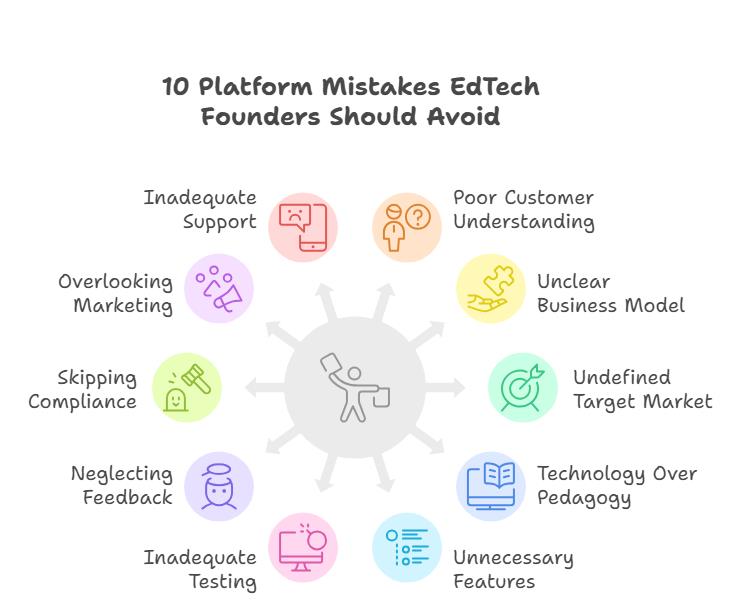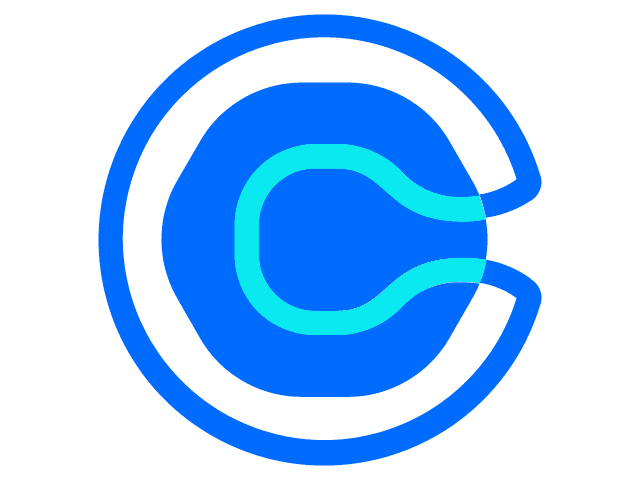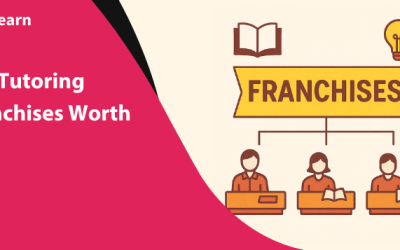10 Platform Mistakes EdTech Founders Should Avoid
Are you a startup founder entering the thriving edtech industry? There’s one thing without which finding success is impossible. Definitely, a well-devised strategy and roadmap!
To establish a clear roadmap, you need a thorough understanding of three key aspects: the market, customer, and your business. That’s exactly where most edtech businesses falter! In pursuit of becoming the next Udemy or Preply, businesses often fail to prioritise customer needs.
The edtech industry is a serious business; hence, we offer all the real-world insights to help you become the next revolutionary in the edtech industry!
10 Top Platform Mistakes EdTech Founders Should Avoid
Many EdTech startups fail early in their entrepreneurial journey. These are the 10 prominent reasons why edtech startups fail.
Let’s briefly look at each of them!

Mistake # 1: Poor Understanding of Customer and Market Needs
Market research and user research build the basic foundation of your edTech platform. Many startups skip the homework and create a product that’s irrelevant!
A thorough market research gives deeper insight into educational challenges and opportunities.
Education is a competitive market with diverse niches. You have K-12, corporate training and language learning.
Furthermore, there are various factors, including user demographics, behaviour, and preferences. Take time to research your audience. That’s when you understand their expectations, pain points and challenges.
Speaking about market trends, the education industry is undergoing a significant shift. AI, VR, and AR are revolutionising the way content is delivered!
Are you creating a tutoring or course platform? You can’t skip on research! It offers insights on user preferences, features, and product enhancements.
Predictive analytics, data analysis & personalized recommendations are some AI-driven insights.
How to Avoid Them?:
Stay abreast with market trends, industry developments, and customer needs to ensure your edTech platform’s success.
Here are the different ways to conduct market research:
- Identify your target audience (students, teachers, parents)
- Define your research goals
- Choose your research methods(interviews, focus groups, case studies)
- Analyze the trends and patterns from the data collected
- Apply your market findings and insights to product development
Mistake # 2: No Clear Business Model
Business model or revenue channel lays the foundation of your edTech platform. It’s how you pump revenue into your edTech platform.
A business model includes the following: value proposition, revenue streams, pricing strategy, and sales channels.
There are a variety of revenue models from simple to complex. For example, there’s subscription, ad-based, and commission-based models.
Now, let’s rewind your business narrative a bit. From planning to marketing, you have a range of costs. Overall, the variable cost is quite high! Hence, it’s difficult for your business to earn a profit.
A robust business model reduces your overall losses and helps you survive in the long run! And a business model that worked for someone might not work for you!
There’s another grave mistake that businesses commit. Raising funding before finalizing their business model. This makes your business quite unclear to investors. And can even repel strategic investors!
How to avoid it?:
- Identify your target market (K-12 students, professionals, higher education)
- Define your unique business proposition
- Explore the pros and cons of different business models
- Choose the business model that best aligns with your platform goals & vision
Mistake # 3: Not Defining Your Target Market
Businesses often lack a clear idea of their target audience.
But, just give it a thought! If you aren’t aware who’ll use your platform, it’s difficult to resonate with them right?
Edtech founders often lack a clear audience persona — demographics, behaviour, motives, and learning preferences.
When you lack this, you often target audiences who don’t have an actual problem. Then, you’re just another edtech business lost in the crowd!
Secondly, entrepreneurs define a generic audience, i.e. consider their platform is for everyone out there.
Narrow down your audience to K-12, professionals, higher education, or corporate professionals. You can even go deeper and target a specific audience based on their demographics, like age, preferences, etc.
Also, don’t ignore the secondary audience in this process. For example, parents or teachers who will actually purchase your service.
Once you have a clear understanding of your audience, you know exactly which channels to target. This significantly saves your marketing costs.
How to Avoid It?
- Identify your edtech niche and your platform’s unique selling point
- Create detailed personas on ideal users with needs, pain points, and motivations.
- Analyze your competitors’ features, prices, and shortfalls
- Leverage market research tools like Google Analytics, Semrush, Ahrefs
- Evaluate their learning style and environment
Mistake # 4: Obsessing Technology Over Pedagogy
Education is amidst a significant technology revolution spurred by AI and machine learning.
There are personalized chatbots refining your sentence construction. Then, there’s surreal VR taking students through virtual trips and science fantasies.
However, technology without pedagogy creates an illusion of a “cookie-cutter approach.” More specifically, a one-size-fits-all approach with limited scalability.
While this might supplement as teaching aids, it can’t replace the core learning experience.
Students can get bored with these mechanised tutors and tools after a few days.
After all, it’s not what technology you use, but how you use it that matters! For example, virtual whiteboards have been a widely adopted technology. However, how teachers use this technology is what determines how widely it’s adopted.
Teachers can deliver an excellent learning experience even with minimal technology. That exactly explains the “technology over pedagogy” concept.
Despite the best lightsaber, Luke Skywalker had to carry Yoda to become the best Jedi. This explains the indispensable role of teachers for successful learning!
For instance, innovative learning techniques like spaced repetition, teachback, and storytelling have stood the test of time.
Solution:
- Start with pedagogy first — assessing your learners’ needs and style. Technology aids should support in achieving these outcomes and objectives.
- Ensure teachers are trained to leverage technology in their classrooms.
- Leverage technology for active participation, like simulations, activities, etc
- Use the TPACK framework(technological, pedagogical, and content knowledge) for techno-pedagogy success.
Mistake # 5: Unnecessary Platform Features
While pleasing your audience, businesses often end up adding too many features. The result? Feature bloat! An edtech platform with too many features.
But, too much of anything is not good, even if it is platform features. You can end up confusing users or making your platform difficult to use.
Loading your platform with unnecessary features can distract your users. More features don’t equate to better learning outcomes.
Some businesses can even offer sophisticated features instead of the essential ones. Thus, learners won’t achieve the actual learning needs and goals.
In the long run, too many features translate to a higher development cost. Also, a cluttered and complex user interface leads to a negative user experience.
Feature fatigue often stems from a poor understanding of your target audience. When you don’t know what your audience wants, you end up offering all the possible features.
Solution:
- Focus on the actual problem instead of just adding new features.
- Ask for every feature: Does it support the core user journey?
- Use data & analytics to find the features that are most and least used
- Prioritise high-value features that address user pain points
⚡Related:
Mistake # 6: Inadequate Testing and Quality Assurance
The primary goal of your edtech business is to shape your users’ learning journey.
There’s no doubt that the edtech industry has fierce competition. Hence, it’s critical to deliver the best user experience and impress your audience!
However, edtech businesses often neglect or rush through the QA part. However, efficient QA testing ensures you deliver a fully functional and reliable edtech platform.
Another important aspect to focus on here is that testing extends beyond usability and accessibility. Your edtech platform should be user-friendly, intuitive, and accessible to different learners.
Now, this includes learners with disabilities as well.
For instance, your math tutoring platform should have alt text for images and keyboard navigation elements.
Lastly, your edtech platform must be accurate and up-to-date. You need to reassess your curriculum for conceptual and factual errors. Errors and outdated concepts are a big turn-off for learners.
Solution:
- Consider different user scenarios and design test cases
- Include accessibility testing for different types of learners. Test for screen readers, keyboard navigation, colours, etc.
- Conduct extensive testing on usability, performance, and educational effectiveness
- Ensure regulatory compliance with accessibility and data privacy
- Collaborate with educators, administrators, and stakeholders to understand their needs and pain points
- Incorporate user feedback loops to refine your educational product
Mistake # 7: Neglecting Customer Feedback
Customer feedback is the greatest form of market research. Between the errands of securing funds, figuring out a business model, and marketing, founders often ignore user feedback.
But, ultimately, users are your key stakeholders. Their customers’ needs, pain points, suggestions, etc., are “unfiltered truth.” It’s your irreplaceable gospel of success guiding you through your entrepreneurial journey.
Customer feedback means actionable insights on product development, strategy and growth.
Collect feedback at different stages of your product journey. From onboarding and usage to renewal and retention, feedback is a powerful tool.
It helps to find how well you fit your customer’s expectations. Also, the way you interact with your clients determines whether customers want to interact with your brand.
Solution:
- Use surveys, interviews, or testimonials to gather specific feedback
- Create focus groups representing specific userbase for in-depth discussions
- User testing offers a rundown on usability and satisfaction issues
- Embed feedback forms to rate the quality of your edtech services
Mistake # 8: Skipping Legal and Regulatory Compliance
In pursuit of the core learning platform goals, businesses often neglect the legal side of their business.
While providing a seamless user experience is a priority, navigating the complex legal challenges is crucial as well. Ignoring it could be a major roadblock to your success.
In the educational industry, content infringement is more common than you imagined. You can use copyrighted images or videos in your curriculum. Or educators might use content from textbooks without proper rights.
Data privacy and security, IPR, and contractual obligations are some key legal areas of concern.
E-learning platforms collect a lot of personal and confidential information. This includes academic records, payment details, biometric data, etc.
Now, dealing with such data without any security measures is tricky. It could lead to privacy breaches and ultimately raise trust concerns.
Regulatory policies vary from region to region. GDPR is applicable to the EU. FERPA and COPPA are applicable for the US. If you’re starting a tutoring business, here are the legal requirements to consider.
Solution:
- Create a privacy policy involving explicit user consent for data collection, usage, and data portability
- Ensure your edtech business complies with local and educational standards
- Register your educational software
- Get your course or online program accredited to build trust and brand authority
- Define who owns the platform content, and also include licensing agreements
Mistake # 9: Overlooking Marketing and Sales Strategy
You might have the best platform features and interface design, but without visibility, it might go unnoticed.
If your customers can’t find your brand anywhere online — testimonials, reviews, etc. This can lead to trust issues and faulty brand perception.
Businesses also end up using the same marketing approach that worked for competitors. But this might not always work! Your edtech business is dealing with a diverse audience or a different target market.
So, you need to identify the platform where your ideal audience typically hangs out.
Secondly, businesses often rely on a single marketing strategy. But, it’s always better to diversify your marketing efforts.
If you own a course marketplace like Udemy, PPC ads could be your go-to marketing channel. Also, create targeted promotional campaigns with seasonal discounts and offers.
Solution:
- Understand your audience’s demographics and psychographic data
- Craft well-defined buyer personas with demographics, goals, pain points, etc
- Track your campaign conversions, CTRs, engagement, ROI, etc
- Segment your audience into small groups for personalised communication
Mistake # 10: Inadequate Customer Support
Offering a customer-centric service non-negotiable. You cannot neglect it while prioritising the core platform features and user experience.
Your platform might offer a host of features, even more than necessary. But if you lack proper customer service or onboarding experience. You are losing a big point! And, this is also one of the biggest mistakes edtech founders commit.
Excellent customer service is what builds a user-friendly platform. For instance, if your platform offers personalised customer support to parents and teachers. This wins trust and builds your loyal customer tribe!
Further, there’s an uptick in your referrals!
How to enhance your customer support?
- Integrate an AI chatbot for answering enrollment questions, fee structure, etc
- Provide an omnichannel support with social media, emails, live chat, etc
- Gather parents’ and teachers’ feedback through surveys, reviews, and interviews
- Create a seamless onboarding experience for learners
- Offer proactive support for technical queries and issues
Wrapping Up
Edtech founders are often so passionate about their vision and solution that they don’t focus on the actual problem. Thus, they skip market research and barely focus on customer pain points.
Further, these grave mistakes ward off potential investors.
While zeal for your business idea is crucial, you can’t go far without a clear strategy! We have covered the 10 common mistakes edtech founders commit, so you can avoid the failure trap.
Avoiding these mistakes by implementing the given solutions helps you offer an enriching learning experience.
While building your edtech business, if you encounter any challenges, you can always reach out to our expert team. We can put our years of expertise to guide you up the entrepreneurial ladder!
FAQ-Related to 10 Platform Mistakes EdTech Founders Should Avoid
1. What are the common reasons Edtech startups fail?
Here are the common reasons why edtech startups fail:
- Poor understanding of the market and customer needs
- No clear business model
- Not defining the target market clearly
- Prioritising technology over pedagogy
- Loading unnecessary features into your edtech platform
- Insufficient testing and quality assurance
- Neglecting customer feedback
- Skipping legal and regulatory requirements
2. How to build an EdTech Business?
Follow these steps to build an edtech business:
- Identify a profitable niche
- Know your target audience and market
- Determine the right business model
- Choose the right platform
- Onboard educators into your platform
- Promote your platform
- Grow your edtech business
3. How do I grow my EdTech Business?
Here’s how you can scale your edtech business:
- Target diverse audiences, countries, and languages
- Leverage technology like LMS software, automated email notifications, and AI chatbots
- Explore monetisation models like tiered pricing, subscriptions, etc
- Diversify your revenue stream with courses, certifications, advertising, etc
4. At what point do most EdTech startups fail?
The first five years are the testing phase for new EdTech startups. Approximately, 80-90% of edtech startups don’t make it through this period. On the other hand, some also don’t make it through the first 18 months.





